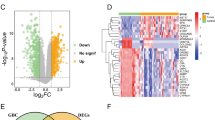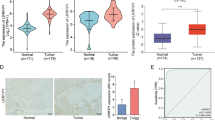Abstract
Aim
Chromodomain helicase DNA-binding protein 5 (CHD5) plays a role in normal neural development and in tumorigenesis of various human cancers. However, its role in primary gallbladder carcinoma (PGC) is still unclear. The aim of this study was to investigate CHD5 expression in PGC and its clinical significance.
Methods
CHD5 mRNA and protein expression in 120 PGC and 20 normal gallbladder specimens was determined by quantitative reverse transcription-polymerase chain reaction (QRT-PCR) and Western blotting analysis, respectively.
Results
The expression levels of CHD5 mRNA and protein in PGC tissues were both significantly lower than those in the normal epithelium of the gallbladder (mRNA: P = 0.006; protein: P = 0.01). CHD5 mRNA expression was closely correlated with its protein expression (r = 0.8; P < 0.001). Additionally, the low expression of CHD5 protein was significantly associated with high pathologic T stage (P = 0.01) and clinical stage (P = 0.008), and advanced histologic grade (P = 0.009). The expression levels of CHD5 protein in PGC tissues with positive nodal metastasis were also significantly lower than those without (P = 0.01). Survival analysis showed that low CHD5 expression was associated with shorter disease-free (P = 0.01) and overall survival (P = 0.008) compared to those with high CHD5 expression in PGC patients. Furthermore, multivariate analyses showed that the decreased expression of CHD5 was an independent prognostic marker for both unfavorable disease-free (P = 0.01) and overall survival (P = 0.006).
Conclusion
CHD5 may be involved in carcinogenesis of PGC and its down-regulation may be significantly correlated with unfavorable clinicopathologic features including poor overall and disease-free survival in patients.


Similar content being viewed by others
References
Puhalla H, Wrba F, Kandioler D, Lehnert M, Huynh A, Gruenberger T, Tamandl D, Filipits M (2007) Expression of p21(Wafl/Cip1), p57(Kip2) and HER2/neu in patients with gallbladder cancer. Anticancer Res 27:1679–1684
Roa I, de Aretxabala X, Lantadilla S, Munoz S (2011) ERCC1 (excision repair cross-complementing 1) expression in pT2 gallbladder cancer is a prognostic factor. Histol Histopathol 26:37–43
Chen Y, Chen Y, Yu G, Ding H (2011) Lymphangiogenic and angiogentic microvessel density in gallbladder carcinoma. Hepatogastroenterology 58:20–25
Misra S, Chaturvedi A, Misra NC (2003) Carcinoma of the gallbladder. Lancet Oncol 4:167–176
Ando A, Suzuki C (2005) Cooperative function of the CHD5-like protein Mdm39p with a P-type ATPase Spf1p in the maintenance of ER homeostasis in Saccharomyces cerevisiae. Mol Genet Genomics 273:497–506
Yoshimura S, Yoshimi T, Ohkawa Y, Azuma M, Tachibana T (2010) A rat monoclonal antibody against the chromatin remodeling factor CHD5. Hybridoma (Larchmt) 29:63–66
Potts RC, Zhang P, Wurster AL, Precht P, Mughal MR, Wood WH 3rd, Zhang Y, Becker KG, Mattson MP, Pazin MJ (2011) CHD5, a brain-specific paralog of Mi2 chromatin remodeling enzymes, regulates expression of neuronal genes. PLoS One 6:e24515
Thompson PM, Gotoh T, Kok M, White PS, Brodeur GM (2003) CHD5, a new member of the chromodomain gene family, is preferentially expressed in the nervous system. Oncogene 22:1002–1011
Koyama H, Zhuang T, Light JE, Kolla V, Higashi M, McGrady PW, London WB, Brodeur GM (2012) Mechanisms of CHD5 inactivation in neuroblastomas. Clin Cancer Res 18:1588–1597
Muthuswamy SK (2009) A new tumor suppressor that regulates tissue architecture. PLoS Med 6:e1000073
Law ME, Templeton KL, Kitange G, Smith J, Misra A, Feuerstein BG, Jenkins RB (2005) Molecular cytogenetic analysis of chromosomes 1 and 19 in glioma cell lines. Cancer Genet Cytogenet 160:1–14
Mokarram P, Kumar K, Brim H, Naghibalhossaini F, Saberi-firoozi M, Nouraie M, Green R, Lee E, Smoot DT, Ashktorab H (2009) Distinct high-profile methylated genes in colorectal cancer. PLoS One 4:e7012
Garcia I, Mayol G, Rodríguez E, Sunol M, Gershon TR, Ríos J, Cheung NK, Kieran MW, George RE, Perez-Atayde AR, Casala C, Galván P, de Torres C, Mora J, Lavarino C (2010) Expression of the neuron-specific protein CHD5 is an independent marker of outcome in neuroblastoma. Mol Cancer 9:277
Lang J, Tobias ES, Mackie R (2011) Preliminary evidence for involvement of the tumour suppressor gene CHD5 in a family with cutaneous melanoma. Br J Dermatol 164:1010–1016
Gorringe KL, Choong DY, Williams LH, Ramakrishna M, Sridhar A, Qiu W, Bearfoot JL, Campbell IG (2008) Mutation and methylation analysis of the chromodomain-helicase-DNA binding 5 gene in ovarian cancer. Neoplasia 10:1253–1258
Mulero-Navarro S, Esteller M (2008) Chromatin remodeling factor CHD5 is silenced by promoter CpG island hypermethylation in human cancer. Epigenetics 3:210–215
Roh YH, Kim YH, Choi HJ, Lee KE, Roh MS (2008) Syndecan-1 expression in gallbladder cancer and its prognostic significance. Eur Surg Res 41:245–250
Alvarez H, Corvalan A, Roa JC, Argani P, Murillo F, Edwards J, Beaty R, Feldmann G, Hong SM, Mullendore M, Roa I, Ibañez L, Pimentel F, Diaz A, Riggins GJ, Maitra A (2008) Serial analysis of gene expression identifies connective tissue growth factor expression as a prognostic biomarker in gallbladder cancer. Clin Cancer Res 14:2631–2638
Ng D, Yang XR, Tucker MA, Goldstein AM (2008) Mutation screening of CHD5 in melanoma-prone families linked to 1p36 revealed no deleterious coding or splice site changes. BMC Res Notes 1:86
White PS, Thompson PM, Gotoh T, Okawa ER, Igarashi J, Kok M, Winter C, Gregory SG, Hogarty MD, Maris JM, Brodeur GM (2005) Definition and characterization of a region of 1p36.3 consistently deleted in neuroblastoma. Oncogene 24:2684–2694
Fujita T, Igarashi J, Okawa ER, Gotoh T, Manne J, Kolla V, Kim J, Zhao H, Pawel BR, London WB, Maris JM, White PS, Brodeur GM (2008) CHD5, a tumor suppressor gene deleted from 1p36.31 in neuroblastomas. J Natl Cancer Inst 100:940–949
Bagchi A, Mills AA (2008) The quest for the 1p36 tumor suppressor. Cancer Res 68:2551–2556
Wang J, Chen H, Fu S, Xu ZM, Sun KL, Fu WN (2011) The involvement of CHD5 hypermethylation in laryngeal squamous cell carcinoma. Oral Oncol 47:601–608
Wang X, Lau KK, So LK, Lam YW (2009) CHD5 is down-regulated through promoter hypermethylation in gastric cancer. J Biomed Sci 16:95
Zhao R, Yan Q, Lv J, Huang H, Zheng W, Zhang B, Ma W (2012) CHD5, a tumor suppressor that is epigenetically silenced in lung cancer. Lung Cancer 76(3):324–331
Wong RR, Chan LK, Tsang TP, Lee CW, Cheung TH, Yim SF, Siu NS, Lee SN, Yu MY, Chim SS, Wong YF, Chung TK (2011) CHD5 downregulation associated with poor prognosis in epithelial ovarian cancer. Gynecol Obstet Invest 72:203–207
Acknowledgments
This work was supported by the National Natural Science Foundation of China (no.81172287).
Conflict of interest
None.
Author information
Authors and Affiliations
Corresponding authors
Additional information
X. Du and T. Wu contributed equally to this work.
Rights and permissions
About this article
Cite this article
Du, X., Wu, T., Lu, J. et al. Decreased expression of chromodomain helicase DNA-binding protein 5 is an unfavorable prognostic marker in patients with primary gallbladder carcinoma. Clin Transl Oncol 15, 198–204 (2013). https://doi.org/10.1007/s12094-012-0903-2
Received:
Accepted:
Published:
Issue Date:
DOI: https://doi.org/10.1007/s12094-012-0903-2




